8 Elements of a Fleet Safety Program


Fleet vehicle accidents are among the most costly of injury claims for business. The average cost of a loss related to vehicle accidents is approximately $70,000. This is almost twice the cost of the average workplace injury ($36,592).¹
Without a formal fleet safety program, you may be putting the welfare of your employees and company at risk. A generic safety program is better than none. But it is far more effective to specifically design a program for your company and your fleet.
A fleet safety program establishes the policies and procedures that are needed to help ensure a safe work environment for employees. It can also help protect against liability from vehicle accidents.
There are no guarantees that an accident will not happen. Because the road is one of the most dangerous places for your employees,² establishing a formal and ongoing program of screening, testing, inspection and training is essential.
The Payoff, Where the Rubber Meets the Road
For any company with a fleet of vehicles of any size, a formal fleet safety plan can provide a number of advantages, including improved safety, employee satisfaction and the potential to improve fleet efficiency.
8 Essential Elements of a Fleet Safety Program
An effective fleet safety program must be comprehensive, up to date and instituted as a part of your company’s safety culture. It should be thorough, reaching each employee who gets behind the wheel. And the commitment has to start at the top.
- Identifying all of your drivers. Businesses may not be aware of the full extent of their non-owned vehicle exposure. You should identify everyone who drives on behalf of the business, even those employees who use personal and/or rented vehicles.
- Management commitment. Leadership support of the program can help assure that the program is used.
- Screening and selecting drivers carefully. This can help create a reliable, safe team. Without safe drivers, no organization is likely to have a good long-term safety record. Establish clear hiring standards and a thorough screening process for anyone who drives on company business.
- Training drivers. This can help to ensure that all drivers understand vehicle safety policies and procedures. All drivers should have access to information on safe driving strategies and techniques, including instruction in defensive driving.
- Managing drivers on an ongoing basis. This is essential in helping to ensure that drivers are following fleet safety rules and driving safely.
- Managing accidents when they occur. This can help mitigate accident costs. It also helps you to understand your exposures and can reduce the potential for future losses.
- Establishing written policies and procedures. This sets clear, consistent expectations.
- Formalizing a plan for vehicle inspection, repair and maintenance. This can help reduce costly, unexpected breakdowns and can assist in avoiding accidents due to faulty equipment.
At Travelers, we take advantage of our deep risk expertise and extensive experience to help our customers design their fleet safety programs and help protect what is important to their business.
Sources:
¹ National Safety Council 2014 Injury Facts Key Statistics
² http://www.bls.gov/news.release/cfoi.t01.htm



